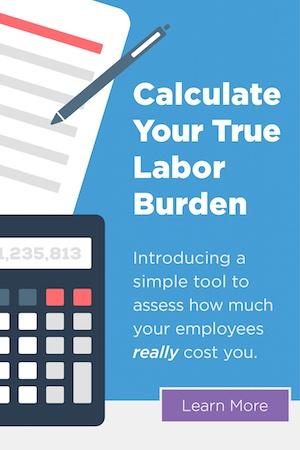About 2.7 million Americans quit their jobs in May of 2015 — nearly two percent of the workforce — up by about a quarter since 2003. “Quits,” as termed by the Bureau of Labor Statistics, held steady at near 2 million month-on-month.
Higher turnover isn’t necessarily a sign of a weakening economy. Employees who leave their jobs might do so because they have more confidence in the job market or increased financial stability.
Employers can also benefit in the form of a more robust and talented pool of job applicants. More likely, however, is that they feel the sting of turnover just as acutely or more. Turnover can cost up to several years of an employee’s compensation, depending on the type of job and value of the employee.
Hiring new personnel takes time and money: posting job opportunities, interviewing candidates, training new employees, as well as losing valuable business relationships and intangible experience, are all costs businesses would rather avoid, if possible. Meanwhile, remaining team members are stretched thin when roles go vacant, and productivity suffers as a result.
Understanding why turnover matters and how to measure it is a lesson every business must learn early on. Analyzing turnover to reveal organizational deficiencies and illuminate avenues for improvement is an ever-evolving artform with which businesses can only hope to keep up with through constant reassessment and self-evaluation.
Here is how to calculate employee turnover and put those statistics to good use:
How to Calculate Turnover
There’s no single turnover variable that gives a business all the answers it needs. Different calculations work best for different purposes:
 Voluntary turnover is the rate at which employees willingly leave a company within a given period. To calculate voluntary turnover rate, divide the number of voluntary separations by the average number of employees during the period and multiply by 100.Voluntary Separations × 100 = Voluntary Turnover %
Voluntary turnover is the rate at which employees willingly leave a company within a given period. To calculate voluntary turnover rate, divide the number of voluntary separations by the average number of employees during the period and multiply by 100.Voluntary Separations × 100 = Voluntary Turnover %
Avg. # of Employees**Avg. # of Employees = (Number at beginning of period + Number at end of period) / 2
 Total turnover calculation is applied to a combination of both voluntary and involuntary separations:Total Separations* × 100 = Total Turnover %
Total turnover calculation is applied to a combination of both voluntary and involuntary separations:Total Separations* × 100 = Total Turnover %
Avg. # of Employees*Total Separations = Voluntary Separations + Involuntary Separations First-year turnover applies to workers who leave during their first year of employment:Voluntary 1st-year Separations × 100 = First Year Turnover %
First-year turnover applies to workers who leave during their first year of employment:Voluntary 1st-year Separations × 100 = First Year Turnover %
Avg. # of 1st-year Employees
How to Analyze Employee Turnover
Calculating turnover figures to get the right number is a relatively simple matter; any business that keeps even modestly updated human resources records should be able to obtain accurate figures using the correct formulas.
What can be more difficult is using turnover figures to draw informed conclusions about how a business operates. A turnover rate of 20 percent may indicate a fundamental problem within an organization; then again, it may simply be business as usual.
A business gains little from its turnover analysis until it has determined what contributes to employee turnover and why those figures may be too high or too low. For example, first-year turnover rates often help to determine whether recruiting firms are adequately vetting candidates, advertisements are conveying accurate job description data, or rival firms are poaching hires after training.
Some factors to consider in determining the causes of employee turnover include:
 Demography: Do a company’s employees tend to be very young, very old? Why have most chosen to work in a particular field? Who employees are is as important to turnover ratios as how they are treated.
Demography: Do a company’s employees tend to be very young, very old? Why have most chosen to work in a particular field? Who employees are is as important to turnover ratios as how they are treated. Industry: Does turnover rate track with industry norms? For example, private sector turnover is generally twice as high as for public sector jobs.
Industry: Does turnover rate track with industry norms? For example, private sector turnover is generally twice as high as for public sector jobs. Region: Turnover rates are generally lower in the Northeast, highest in the South.
Region: Turnover rates are generally lower in the Northeast, highest in the South. Compensation: Few would expect a minimum-wage earner to feel as tied to his position as a salaried employee receiving benefits. Beyond base pay, a company that doesn’t offer industry-competitive rates can expect trained employees to jump ship when positions become available at competing organizations.
Compensation: Few would expect a minimum-wage earner to feel as tied to his position as a salaried employee receiving benefits. Beyond base pay, a company that doesn’t offer industry-competitive rates can expect trained employees to jump ship when positions become available at competing organizations. Company Culture: Work-life balance, professional development, engaged leadership, employee recognition — a career is more than just a job, after all. Employees who feel happy and safe where they work are less likely to leave by choice.
Company Culture: Work-life balance, professional development, engaged leadership, employee recognition — a career is more than just a job, after all. Employees who feel happy and safe where they work are less likely to leave by choice.
Turnover is an essential element at any company. High incumbency rates often indicate over payment for skills which may be available cheaper somewhere else in the job market. A stagnant workforce cannot hope keep up with the pace of business innovation, even in relatively slow-changing industries. Businesses must face the fact that some turnover is not only inevitable but also necessary.
But too much turnover can indicate problems in an otherwise healthy organization. Those tasked with measuring these rates and recommending changes carry a great responsibility. Employees who can live up to that standard are certainly ones you’ll want to keep.
For more information on how to calculate your company’s turnover rate visit our Training Portal.



